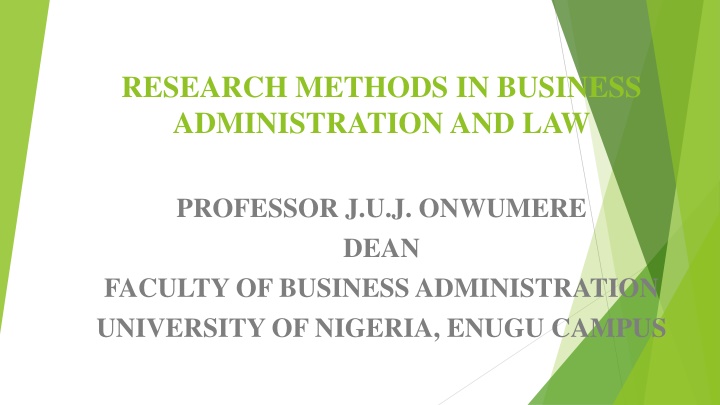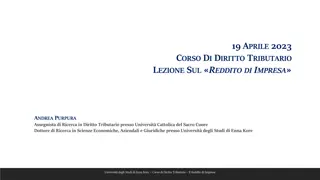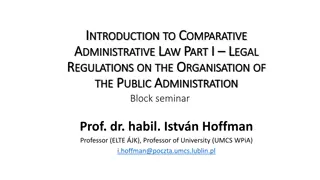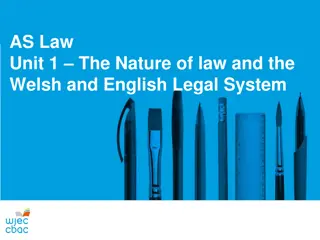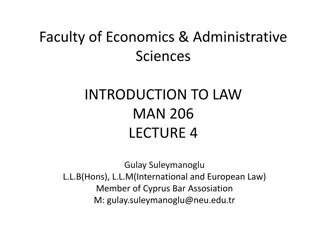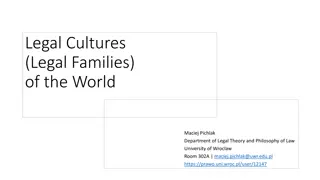Research Methods in Business Administration and Law: Understanding the Research Process
Research is a systematic inquiry aimed at discovering new knowledge, validating existing phenomena, and aiding decision-making processes. This comprehensive guide delves into the definition, features, aims, and significance of research in the fields of business administration and law. It explores the functions of research, emphasizing its role in advancing knowledge, informing decision-making, and contributing to the literature. The research process is outlined, detailing steps such as problem identification, hypothesis formulation, data collection, and analysis. This resource offers valuable insights for students, professionals, and academics looking to enhance their research skills across various disciplines.
Download Presentation

Please find below an Image/Link to download the presentation.
The content on the website is provided AS IS for your information and personal use only. It may not be sold, licensed, or shared on other websites without obtaining consent from the author.If you encounter any issues during the download, it is possible that the publisher has removed the file from their server.
You are allowed to download the files provided on this website for personal or commercial use, subject to the condition that they are used lawfully. All files are the property of their respective owners.
The content on the website is provided AS IS for your information and personal use only. It may not be sold, licensed, or shared on other websites without obtaining consent from the author.
E N D
Presentation Transcript
RESEARCH METHODS IN BUSINESS ADMINISTRATION AND LAW PROFESSOR J.U.J. ONWUMERE DEAN FACULTY OF BUSINESS ADMINISTRATION UNIVERSITY OF NIGERIA, ENUGU CAMPUS
INTRODUCTION DEFINITION AND FEATURES OF RESEARCH The Webster s NEW ENCYCLOPEDIC DICTIONARY defines research as a careful or diligent search, studious inquiry or examination, investigation or experimentation aimed at the discovery and interpretation of facts, revision of theories or laws in the light of new facts . Kerlinger (1973) defines it as a systematic, controlled, empirical and critical investigation of hypothetical proposition about presumed relations among natural phenomena (p. 11). Bennet (1983:24) equally views it as a systematic and careful inquiry or examination aimed at discovering new information or relationship and to expand/verify existing knowledge for some specified purpose Onwumere(2009) views research from a holistic perspective as an organized search for the truth about identified problems, challenges and phenomena through investigation and analysis and proffering of relevant solutions or recommendations.
Features of Research Research is a human activity aimed at discovering the truth about phenomenon. Research involves the use of resources. Research involves organisation. Research is a process. Research is systematic. Research is directed at problems or challenges. Research must have theoretical backing. Research involves data gathering, inferencing and analysis. Research must aid decision-making. Research is cumulative. Research is time-bound.
What Research aims to accomplish Validating or invalidating existing phenomena; Discovering new frontiers of knowledge; Contributing to the body of existing knowledge, i.e. expanding the existing frontiers of knowledge; Aiding the process of theory construction; and Proffering solutions to relevant problems or challenges.
FUNCTIONS/SIGNIFICANCE OF RESEARCH - Why study research? Research serves as a veritable source of information Research has become necessary to aid decision-making especially for those organizations that adopt the scientific approach to taking decisions Research helps man to properly understand and utilize resources provided by nature. Research aids appropriate and sound policy making. Research helps in advancing the frontiers of knowledge. Research helps in skills development and enhancement of experience of the undertakers. Research adds to the literature on existing body of knowledge in the particular area under study.
THE RESEARCH PROCESS Identification and formulation of the problem to be investigated Careful study of the background to the problem Defining the objectives and scope of the study Formulation of hypothesis/hypotheses Doing a literature review on the specific area of investigation Provision of criteria for measurement of identified variables Development of a good methodology Cost estimation Conduct of the research Analysis and Report writing
TOPIC SELECTION IN RESEARCH Choosing a topic for research can be quite challenging to the student. It is at the same time something that could be quite simple. Potential sources of topics for business, economic, social, and legal research include the following: Unpublished research works such as projects, dissertations and theses. Some of these may suggest areas for further research. I. Published research works in academic journals or publications of research institutes, bureaus, etc. II. III. Government publications Events of contemporary nature such as regularly in the news media IV. Discussions with practitioners and colleagues
ESSENTIALS OF A GOOD RESEARCH/RESEARCHER For a research to be adjudged to be good, it must exhibit the following features: a) Clarity of Problem Statement b) Clarity of Statement of Objectives c) Evidence of Detailed Research Proposal d) Evidence of Detailed Methodology e) Application of High Ethical Standards Adequate Data Analysis f) g) Findings and Conclusions Appropriately Drawned and Justified h) Limitations are Honestly Revealed Reflection of Researcher s Experience i)
THE ENVIRONMENTS OF RESEARCH An environment can be defined as a setting in which certain variables operate and have direct and indirect effects on each other individually or collectively or both in diverse dimensions. It creates a set of conditions and forces that present certain opportunities, threats, weaknesses/challenges and strengths to its within-operators and regulators. It thus, throws up a lot of issues and variables of research interest and endeavours.
Components of Environment There are two key components of an environment. These are: The internal and 1. 2. The external environment.
Internal Environment An internal environment represents the within (in or internal) setting of anything or matter. Another name for the internal environment is the micro- environment. Thus, it is an internal setting where there is the interaction of the forces of production to generate output(s) and or service(s). These forces or variables may be land, labour, capital and raw materials, all of which are under the control of the organization.
Internal Environment Contd. The production function in this case may be expressed as: Q = f (Ld, Lb, K. R) . (2.1) where, Q = Output, f = Function, Ld = Land, Lb = Labour, K = Capital, and R = Raw materials.
Internal Environment Contd. Beyond these, other aspects of the internal environment of an organization include: The Organization s Processes i. The Organization s Organogram ii. iii. The Organization s Culture iv. The Organization s Resources and their Linkages The Organization s Climate v.
External Environment The task environment represents the immediate environment that affects a behavioural unit. With respect to a business organization, it represents that industry in which the business unit operates. This includes: 1) The economic environment 2) the socio-cultural environment 3) the political environment 4) the legal environment 5) the business environment 6) the international environment
Concepts, Variables and Causality MEANING OF CONCEPT Concepts generally are our abstractions from reality expressed in definite words or phrases for ease of identification of a particular phenomenon or phenomena. They are thus peculiar, in the main, to such situations. In this way, concepts represent definite items that can be defined, such as fixed assets, output, production, advertising, etc. Concepts are symbols of phenomenon but are themselves not phenomena (Nachimas and Nachimas, 1976) A concept has been defined in the following way: ... an abstract symbol representing an object, property of an object, or a certain phenomenon. For example, status , role, power , and relative deprivation are common concepts in political science and sociology. Concepts such as intelligent , perception , and learning are common among psychologists (Nachimas and Nachimas, 1976:15).
Concepts Contd. It (concept) has also been defined and described as: a generally accepted collection of meanings or characteristics associated with certain events, objects, conditions, situations and behaviours. Classifying and categorizing objects or events that have common characteristics beyond any single observation create concepts. The terms height , width and depth , for example, symbolize a conception of the properties of a physical object. Similarly, the economic term profit points to the financial situation of an organization (Blumberg, Cooper and Schindler, 2011, p. 25). Concepts are therefore relevant within the context of their meanings and functionality. They can be seen as our abstraction, thoughts about reality which we have expressed in certain words or phrases.
SOURCES OF CONCEPTS IN RESEARCH These are: Language and Culture Observation Borrowing Experience
SIGNIFICANCE OF CONCEPTS Permit communication Permit research Enable the classification or categorisation of objects and policies, among others They specifically aid science and scientific research Aid general comprehension of the relevant issues at stake
CONSTRUCTS These are theoretical inventions by an individual or individuals which have become accepted even when they have no dictionary meaning. In this regard, constructs which are concepts by nature have been deliberately invented for the purpose of research. A construct is a special concept. Examples conditionalities timber and calibre ; cognitive dissonance ; etc. (Osuagwu, 1999:6). of constructs include International Monetary Fund s
VARIABLES DEFINITION OF VARIABLE Variables are the essential ingredients of analysis in any research. They are seen as those rational units of analysis that can assume any one of designated sets of values. Variables could at the theoretical level not be subject to any form of values or numerals but at the level of empiricism, this cannot be avoided.
TYPES OF VARIABLES There are various types of variables. They are often better understood in relation to each other. Researchers are interested in variables because of their functionality in relation to the problem of their study or in aiding analysis with respect to the study. Numerical Variables: These are variables with values that can be expressed in numbers. Examples of numerical variables are gross domestic product (in monetary terms), weight (in kilograms), and height (in meters). Categorical Variables (or Discrete Variables): These are variables whose values can be expressed in categories or scales or types. Examples are colour (which can be categorized into white, blue, red, green, yellow, brown, among others), income level (low, middle and high, among others), etc. Numbers could be assigned to each of the categories such as 5, 4, 3, but with no option for 4.5 or 3.5 in that order. Discrete Random Variables: These are peculiar types of random variable in the sense that their values are limited. The number of values are countable.
TYPES OF VARIABLES Contd. Dichotomous Variables: These are variables that have only two values, without any in-between properties. Example is gender (male or female). One cannot be male and female at the same time. The male can be assigned value of 1 and the female, a value of 0. Continuous Variables: These are variables whose values are taken within a given range within an infinite range. An example of these variables is one \ s examination score in a range of 100%. Someone s age ia another example. Where it will end is unknown to man
Types of Variables Contd. Other notable variables which researchers are even more interested in because of their functional relation to the problem being investigated include as follows: a) Independent Variables b) Dependent Variables c) Intervening Variables d) Moderator Variables e) Extraneous/Control Variables Dummy Variables f) g) Lagged Variables h) Background Variables Random Variables i)
CAUSALITY DEFINITION OF CAUSALITY Causality has to do with generating, leading or effecting. Causal variables are those having effect on other variables. This effect could be positive or negative, significant or insignificant. The issue of causality has arisen because of the relationship that exists in real life among variables
CRITERIA FOR CAUSALITY There are at least 3 conditions to be met to establish a causal relationship between two variables: 1) Association is demonstrated between them. This is, more often than not, derived from theory. 2) Variables must exist in a particular time order. 3) It must be shown that the relationship between the two variables persists when other variables that precede them in time are variables that could possibly apply for the relationship.
SPURIOUSNESS When a relationship between two variables has occurred by accident and does not imply a causal relationship at all, it is describable as spurious. It thus represents a kind of inaccuracy but in a special way. Spuriousness occurs especially when we are making use of time series data in regression equations. Most time series data are non-stationary and this has the inherent danger of leading us into obtaining regression results which are good high coefficient of determination (R2), significant t-values, etc. but which are meaningless. This is because the relationship between the variables is false. The data used for their estimation should have been stationary to make meaning and be reliable. To avoid having spurious regressions as associated regressions are called, it is necessary to test data for their estimation for stationarity and non- stationarity.
HYPOTHESIS, MODELS AND MODELING IN RESEARCH, AND THEORY DEFINING HYPOTHESIS Hypothesis is very important in research and is better defined within the context of proposition(s). A proposition is seen as a statement referring to the situation of a concept or a suggestion that is yet to be proven true or false about observable behavioural settings. It is a form of supposition or conjectural belief. A hypothesis is therefore a declarative proposition that has to be tested to determine whether it is acceptable or not with respect to the case in question. We formulate hypothesis for the purpose of testing it. In this way, a hypothesis is a tentative statement about phenomena whose validity is usually unknown. It is thus a statement of probability. It is a statement that so far is not supported by relevant information or data. It is often stated to highlight the perceived relationship between a dependent and an independent variable.
Hypothesis Contd. It is much better and for ease of testability that a hypothesis should have: 1) Magnitude, and 2) Direction Having magnitude and direction are therefore very critical in almost all hypotheses. They assist a lot in the testability of a hypothesis. It is because a hypothesis will be tested to determine its validity that, more often than not, during the process of testing, it is restated into null and alternate forms
TYPES OF HYPOTHESIS Research Hypothesis Null Hypothesis Alternate Hypothesis Statistical Hypotheses Causal Hypothesis Relational Hypotheses
Sources of Hypothesis There are many sources of hypotheses which include, among others: The state of knowledge available in the area of investigation theories, literatures, etc. The researcher s cultural background: The culture, under which a researcher was nurtured, influences his perception about phenomena. The researcher s intellectual training. The objectives of the study, the problem statement and the research questions.
Functions of Hypothesis These include: a) To test theories b) To suggest theories c) To describe economic, business or social phenomena d) To guide on the form and choice of appropriate research design e) To give direction on data collection To give direction on the technique of data analysis f) g) To guide the researcher in addressing the problem that necessitated the study h) To guide the researcher in making relevant suggestions and recommendations from the exercise
QUALITIES OF A GOOD HYPOTHESIS A good hypothesis must possess the following qualities: 1) It must be as simple as possible. It has to be easy to understand. 2) It must not be ambiguous. It must not be verbose and conflicting. It must be clearly stated and specific. 3) The concepts or variables therein must be easily identifiable and understood.
REQUIREMENTS NECESSARY FOR HYPOTHESIS TO BE RESEARCHABLE a) It must be simple and clear (unambiguous) b) It must be specific. There should no room for over-generalisation. It should state the expected relationship and the conditions where possible, under which it could exist. c) It must be testable using available and relevant methods.
MODELS AND MODELING IN RESEARCH DEFINING MODEL The Complete Reference Library (Computer CD) defines a model as a schematic description of a system, theory, or phenomenon that accounts for its known or inferred properties and may be used for further study of its characteristics . A model as depicted above is an abstraction of aspects of reality. In fact, it is a simplified view of reality designed to enable us describe the essence and inter relationships within the system or phenomenon it depicts (Yomere and Agbonifoh, 1999: 37). A model can, therefore, be seen as an abstraction from reality or phenomenon (thus, an aspect of reality or phenomenon) but at the same time, reflecting reality or phenomenon and which can be subjected to test (testable). It can be viewed as a prototype or representation of a system which has been specified for the purpose of assessing that part or the whole system.
MODEL Contd. Different types of models exist as they are found in all disciplines. We have different models of vehicles even from the same manufacturer. Models can be constructed for the purpose of improving service delivery, quality of life, among others, within a setting. In capturing the representative nature of models, Hawes (1975) posits that: A model is not an explanation; it is only the structure and/or function of a second object or process. A model is the result of taking the structure of one object or process and using that as a model for the second. When the substance, either physical or conceptual, of the second object or process has been projected onto the first, a model has been constructed (p. 22).
MODEL Contd. Generally therefore, a model serves to: a) Guide the researcher in his study, b) Identify the relevant variables into dependent and independent variables where necessary, c) Specify the relationships that exist or could exist between these variables, and d) Enable him formulate and test his hypotheses. As summarized by Marking (1974:79) and cited in Yomera and Agbonifoh (1999): Models then can be either simple or complex structures, but invariably they have one central purpose and that is to help man think rationally. They do this by enabling him to take a complex process or phenomenon and to reduce it to what analysts believe to be a series of meaningful variables. Most often, the analysts divide these variables into at least two categories: independent and dependent variables (p.37).
MODEL Contd. Example of a model is given below: Q = f (K, Ld, L, R) (4.1) where, Q = output; K = Capital equipment; Ld = Land; L = Labour; and R = Raw materials.
MODEL Contd. Here, the model is saying that output (the dependent variable) arises from production due to the combination of the independent variables-capital equipment, land, labour and raw materials. The function (4.1) above can be written in a more testable form as: Q = ao+ a1K+ a2Ld + a3L + a4R . (4.2) a1, a2, a3, a4> 0 where, a1, a2, a3 and a4are coefficients of the independent variables. It is obvious that models abstract from and reflect reality, and are therefore testable.
TYPES OF MODELS There are various types of models as we said earlier. They abound in all fields of human endeavour. Hawes (1975) presents three types of models arising from their functionality. They are: Descriptive Models: These are those models that describe how some elements behave in a system especially in situations where there are no existing associated theories or the existing theories are simply inadequate. Explicative Models: These are those models that provide explanations leading to better understanding of the concepts in relevant well-developed theories or on the application of these theories Simulation Models: These are models that provide clarifications on the structural and process relationships existing between concepts in a theory.
QUANTITATIVE MODELS These are models related to quantitative types of research. They are models that can make or make use of data that are of numeric form. Illustrative examples of quantitative models is he Simple Linear Regression Function This is the simplest form of a quantitative model. It is often a two-variable model in which there is a dependant variable and an independent variable. Example is Y = f (X) (4.1) Where y is the dependent variable, and X = the independent variable.
QUALITATIVE MODELS These are models associated with qualitative research. They are often dealing with why certain actions or outcomes occur. In this respect, they are descriptive in analysis focusing Nevertheless, such information could be converted into numerical for quantitative analysis. more on perceptions and opinions. Qualitative models or qualitative response models are such in which the regression, dependent or response variable is of qualitative nature. It could be continuous but not fully observable because it is dichotomous. It exists in such a way that it takes more than one value. Its range of values is constrained and may not be fully observable. Qualitative models often have the outcomes or response variable being of a product of selective choice, hence its value may be a yes or no decision with yes having a value of for example, 1, and no, a value of for example, zero. In this case, the regression is binary.
QUALITATIVE MODELS Contd. Models of qualitative nature are expected to satisfy certain conditions which include: The dependent variables must have a range of values or classifications which a choice has to be made. a) The value of the classifications or choices must be finite. b) The set of choices must be independent of each other (mutually exclusive). c) Only one choice must be made at a time. d) The choice made represents the dependent or response variable or regression. e) The dependent variable is therefore a discrete variable representing this choice category that it incorporates. f) They must satisfy the explanatory adequacy including their estimates which would have to be accurate. g) Set of choices or classifications should be presented in such a way that they are collectively exhaustive. h)
THEORY A theory has been looked at from different perspectives. Some have seen it as: a) Unsubstantiated ideas. b) A mystique. c) Confirmed postulates. It has also been defined as a set of interrelated concepts, definitions, and propositions that presents a systematic view of some phenomena (Kerlinger, 1973).
Theory Contd. Generally, for sets of ideas to satisfy theoretical acceptability, they must conform to the following: a) They must be logically consistent: There should be no discernible internal contradictions. b) They must be interrelated: There should be no statements about phenomena unrelated to another. The statement should be exhaustive: They should cover the full range of variations about the nature of the phenomena in question. c) d) The propositions should be mutually exclusive: There should be no repetition or duplication. e) They must be capable of being subjected to empirical scrutiny : They should be amenable to be tested through research. This is the only way to determine their scientific worth.
THE SCIENTIFIC METHOD OF RESEARCH The scientific method includes the following: a) Problem identification b) Problem definition c) Concept formation d) Induction e) Conduct of the empirical study Deductions f)
FEATURES OF SCIENTIFIC RESEARCH/ACTIVITY There are several characteristics which when taken together constitute the key elements of any scientific activity. These qualify any research to be regarded as scientific: a) Such an activity must be empirical b) It must be theoretically based c) It must be cumulative d) It must be non-ethical
CLASSIFICATIONS OF RESEARCH BY PURPOSE PURE OR BASIC RESEARCH This is the type of research aimed at inquiring further into existing theories with a view to analyzing, expanding or even refuting them at the conceptualization (non-practical) level. It is, therefore, directed at the development of theories and in so doing, extends the frontiers of knowledge. An example of basic research is An Examination of Production Theory. APPLIED RESEARCH This is the opposite of pure or theoretical research and involves the application of theory to relevant situations or phenomena. Thus, this kind of study is empirical as data are used to substantiate a certain position or invalidate that position or to validate or invalidate a theory. The relevance of applied research is that it is directed at solving problems of practical significance. It must therefore, come up with solutions to relevant problems. Examples of applied research are: A Study of Employee Motivation in XYZ (Nig) Plc. i. Impact of Monetary and Fiscal Policies on the Nigerian Economy, 2010 2025. ii. Marketing of Credit Products and Customer Patronage in the Nigerian Banking Industry: The Case of First Bank of Nigeria Plc. iii.
CLASSIFICATIONS OF RESEARCH APPROACH DESCRIPTIVE RESEARCH Studies of the nature of descriptive research aim mainly at collecting information that reveal the characteristics or features of an existing phenomenon. In the opinion of Cohen and Manion (1980), these studies are concerned with: Conditions that exist, practices that prevail, beliefs, points of view, or attitudes that are developing. At times, descriptive research is concerned with how what is or what exists, is related to some preceding event that has influenced or affected a present condition or event (p. 48). Thus, descriptive research generally aims at the following: Identify current or existing problems; 1) Collect information or data with a view to describing existing conditions, characteristics or phenomena; 2) Make comparative analysis of these features or characteristics, as relevant; and 3) Provide good insights into circumstances surrounding the issues under study and enough guide (through information gathered) for decision making or for further investigation. 4)
CLASSIFICATIONS OF RESEARCH APPROACH Contd. Data, under this type of research, are usually gathered through any of the following methods: Questionnaires: Standardized or open-ended or both inclusive. Interviews: Direct (one on one) or through the mail system or by telephony or the internet (information communications technology). Direct Observation. Examples of descriptive research include: Studies that seek to ascertain perceptions of respondents on some relevant variables (e.g. perceptions of workers on management style/strategy; perceptions of customers on the corporate image of the relevant organization; etc). Studies into current management styles, marketing strategies, motivational variables in place in organizations; etc. Studies assessing the quality of goods and services offered by some specialized organizations.
HISTORICAL RESEARCH As the name implies, this involves studying facts and variables relating to past events with a view to arriving at some relevant judgments. It will include the collation of past data. Thus, a historical research will provide relevant answers to the following: 1) What were the things that happened in the relevant period? 2) How did these things occur, in what dimensions, etc? 3) What were the causal factors (remote and immediate)? 4) What were the specific effects of each factor? 5) What relevant lessons could be drawn in view of current events or how relevant has the study been in comprehending current issues?
